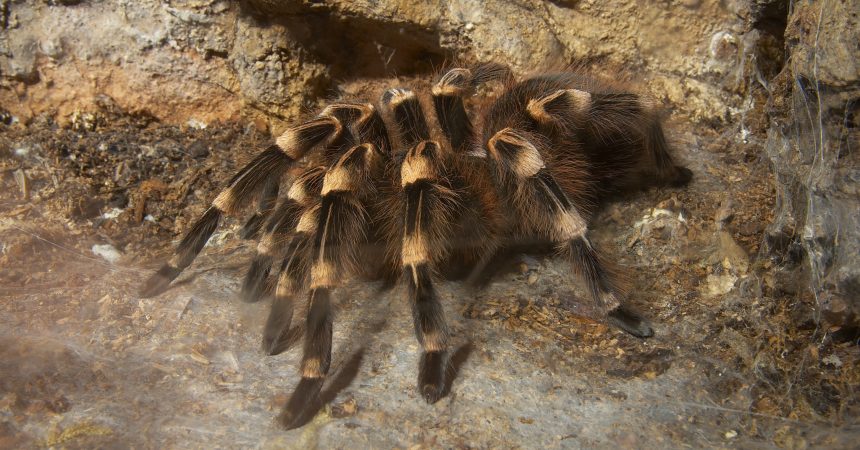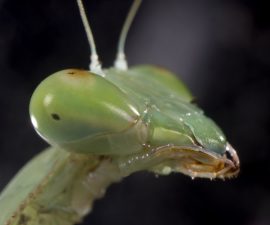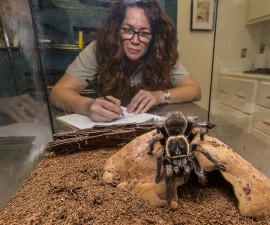Look up in the capital city of Madagascar, Antananarivo (aka “Tana”), and you will find more than fierce blue sky and an array of endemic birds that rivals all others on Earth. Strung between power line after power line, an opportunistic predator makes its home. It is comparatively small, with a body length of up to three inches, yet its hand-crafted abode can span more than three feet in diameter and is constructed from a material both stronger than steel and light as a feather. Have you guessed it?
The silk of spiders, such as that of the golden silk orb weaver Nephila inaurata madagascariensis that I describe above, has long been a source of fascination and industry for our species. Throughout history, mankind has used it for fishing lines, wound dressings, nets, crosshairs in weapons, textiles, protective coverings and even pantyhose! It is renowned for its strength and versatility, and the ability to withstand remarkable amounts of stress before breaking. For this reason, spider silk holds tremendous promise for the production of multiple technologies that require weapons-grade strength and elasticity; it is not surprising that current research proceeds at full pace in this direction.
But how do the spiders use it? Let me count the ways! Research indicates that there are more than 40,000 species of spiders, with each spider species capable of producing up to seven different types of silk. At the Arachnid Rescue Center (ARC) in Discovery Outpost at the Zoo, we get to see several of these silk strategies up close—let’s take a look at a couple.
Tarantulas in the Family Theraphosidae include some of the largest spiders in the world. The Brazilian white knee birdeater (which, incidentally, rarely eats birds) can obtain a body length of 4 to 5 inches, with a leg span of 10 inches or more. These secretive, solitary predators lie in wait in a forest floor burrow and rely on ambush tactics to catch prey—and any small rodent, lizard, amphibian, or invertebrate is fair game. They do not depend on silk to catch their prey, yet they produce it in spades. Why?
There are many reasons—but probably the most interesting use of tarantula silk is the creation of the sperm web by males. Since tarantula fertilization is external, the male must lay down a complicated sperm web structure, deposit sperm onto it, and then pick up the sperm in his pedipalps (accessory structures near the fangs that resemble short legs). He must then convince a female to allow him to inseminate her while immobilizing her fangs and exposing her vulnerable underside—and dancing is involved. Unfortunately for him, she is just as likely to eat him as mate with him, but the silk provides the crucial assist for transferring sperm to the pedipalps and initiating reproduction. So while it is true that bad dance moves can get a male tarantula killed, he can’t even get invited to the ball without silk!
This magical material called silk is actually the foundation of most important functions in spiders. From the impenetrable fortress of the nursery web spider, to the spiky, mace-like egg cases of brown widows, the best protection for developing spiders is silk. And when they emerge as spiderlings, they use silk to make their way into the world by either ballooning out onto the wind or dropping down on a lifeline to see what’s below.
Our recently acquired Malaysian huntsman spiders employed this protective strategy shortly after their arrival. These spiders are also ambush predators, but are smaller than tarantulas with flattened bodies and lightning-fast reflexes. After a few days in the ARC, two of the females produced flat, disc-like egg cases made out of silk, and anchored these egg cases with more silk to the roof of each enclosure. As the eggs (200 or more) developed inside, the females guarded them fiercely.
One morning, the keepers working in the ARC noticed that one of the clamshell-like egg sacs had popped open (or more likely, been torn open by Mom), and there were dozens of tiny, white spiderlings everywhere inside the enclosure—and out. Luckily, the glass enclosures had been doubly-contained in a fine-mesh butterfly enclosure a few days prior, hedging against the probability of tiny spiders that could escape even an exhibit with tight tolerances. It turned out to be a very good call!
I guarantee that spiders use silk in ways you have never heard of—everyone recognizes the traditional orb web, lined with sticky strands for capturing prey, but do you know about the ogre-faced spider that literally tosses its web onto unsuspecting meals? Or the fishing spider that tethers out on a strand of silk from a freshwater shoreline to float patiently on the water, never breaking the surface tension, in order to grab prey falling from the leaves above?
On a local note, there are many fascinating uses of silk right in our own backyard. The California trapdoor spider, Bothriocyrtum californicum, usually gets noticed this time of year as males patrol for females in the fall. This spider lives in silk-lined burrows with a thick “door” made out of soil and silk. They wait just inside the burrow, door ajar, and lunge out when a prey item passes over the threshold. The door is almost indistinguishable from its packed-soil surroundings, and the strategy is very effective. So effective, in fact, that you have likely walked over a few burrows while visiting wilder parts of San Diego—so feel lucky you are not a cricket!
Though we often only think of spider webs this time of year in the context of Halloween, the reality is that they have such a fascinating diversity of applications in the spider world and so much potential in our own. Spiders deserve so much more than fear-inducing stereotypes at holidays—so get out there and (safely) look for them! Did you know that our native orb weavers have their own kleptoparasitic spiders that live off prey scraps in the web, called dewdrop spiders? Trashline spiders, jumping spiders, sow bug killers…find the silk, and follow it to its creator—you’ll be amazed at what you learn.
Paige Howorth is the associate curator of invertebrates at the San Diego Zoo. Read her previous blog, It’s (Almost) Black Tuesday for Bees.





